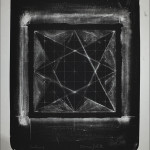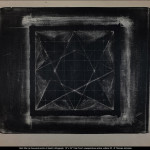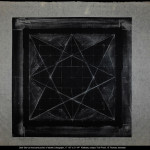
Dark Star – lithograph, hand-drawn, on stone, that began as an investigation of opposites using black and white, pairing order and chance, a structured network in contrast with coarse and smooth textures emphasizing the grain of the stone. I approached the image using chiaroscuro, a manière noir method of drawing, creating light from dark. I used a variety of tools and materials – needles, blades, scraping implements, sandpaper, bronze wool, and solvent. After laying down a double base of asphaltum, rubbed into and buffed on the surface of the stone, I incised the underlying structural grid into that smooth darkness. Then I subtracted further from the dark, and combined this with re-working through additions, physical and chemical, proofing, counter-etching, re-etching, and using gum stencils – thus taking advantage of the plasticity of the lithographic processes.
Dark Star is the final image in a series using a square based grid as a design element. The beauty of the square allowed for the investigation of a primary shape, the building of a static grid image, which begged for transformation and a challenge to go beyond repetition.
The edition of 35 was printed from the stone using Shop Black ink on Rives BFK. In addition to presentation proofs for the printers of the final edition, master printer Craig Keller and artist Joni Papp, a few unique state proofs exist. There is one on newsprint, another on lightweight Rives, and one on a sheet of Kitakata. Two show the full image of the stone complete with test markings in the margins, outside of what would be the final image area. They exist as a unique record of how an image evolves during its creation, a record in the medium of the final edition. I have always found state proofs intriguing in that they can be both record and a component or element in a series and exist to illustrate an artist’s working method and visual choices. I also reserved a few proofs, outside of the edition, to draw on and experiment with – part of my working method for creating future images.
The summer following completion of the edition we traveled in Europe to see Documenta IX, in Kassel, and interview for a residency in the south of France (that is a topic for another post). We visited friends in Bordeaux, in Paris, and near Antwerp: Hugo Besard and family, and Rudolf Broulim. When we were setting the date for the visit, Rudolf said there would be a surprise at the studio. He and Oldřich Kulhánek were just finishing a new body of work and Oldřich was exhibiting at a venue nearby. As it turned out Oldřich was at the workshop on the day of our visit. I had taken one of the impressions as a gift for Rudolf; when I brought it out, Oldřich also enjoyed seeing the image and thus began the discussion about the political implications of the title; and since I had a few impressions with me, it was a pleasure to leave one with Oldřich as well.
Oldřich’s responses to the lithograph’s title, Dark Star, were informed by his experience under Czechoslovakia’s repressive Communist regime. As noted in a Wikipedia entry he had been imprisoned, and interrogated on a regular basis:
“In 1971 he was arrested by the StB (the Czechoslovak Secret Police) and imprisoned for “defamation of the allied socialist states”. In a graphic cycle created from 1968 to 1971, he included “a distorted portrait of Joseph Stalin, perforated five-pointed red stars or joyful faces of socialist workers turned into a hideous grin”. The graphics were identified as “ideologically dangerous” and condemned to destruction. Kulhánek spent a month in prison and was interrogated regularly for next two years. He was prohibited from publishing.”
Once his images landed on the international stage he was able to show the world the face of oppression and brutality through his beautifully drawn images, often satirizing the regime of his interrogators. He had the creative genius to show this even though those critical images had to pass the censors. Oldřich and Rudolf were best of friends from their student days and their close friendship included their artistic collaboration – Rudolf was Oldřich’s printer and brought to life many of his powerful and profound images.
Dark Star’s subtitle – “a thousand points of death” – came about from discussion with Oldřich and Rudolf that day. When I mentioned the image and title as a dark star, Oldřich, ever aware of contemporary issues and political discourse, added with his wry sense of irony “a thousand points of death,” in reference to “a thousand points of light,” George H.W. Bush’s presidential slogan and media campaign of the early 90s.
- lithograph 19 3/4″ x 19 1/2″




